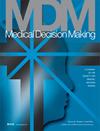Exploring Structural Uncertainty in Cost-Effectiveness Modeling of Gestational Diabetes Screening: An Application Example from Norway
IF 3.1
3区 医学
Q2 HEALTH CARE SCIENCES & SERVICES
引用次数: 0
Abstract
BackgroundScreening pregnant women for gestational diabetes mellitus (GDM) has recently been expanded in Norway, although screening eligibility criteria continue to be debated. We aimed to compare the cost-effectiveness of alternative GDM screening strategies and explored structural uncertainty and the value of future research in determining the most cost-effective eligibility criteria for GDM screening in Norway.DesignWe developed a probabilistic decision tree to estimate the total costs and health benefits (i.e., quality-adjusted life-years; QALYs) associated with 4 GDM screening strategies (universal, current guidelines, high-risk, and no screening). We identified the most cost-effective strategy as the strategy with the highest incremental cost-effectiveness ratio below a Norwegian benchmark for cost-effectiveness ($28,400/QALY). We excluded inconclusive evidence on the effects of screening on later maternal type 2 diabetes mellitus (T2DM) in the primary analysis but included this outcome in a secondary analysis using 2 different sources of evidence (i.e., Cochrane or US Preventive Services Task Force). To quantify decision uncertainty, we conducted scenario analysis and value-of-information analyses.ResultsCurrent screening recommendations were considered inefficient in all analyses, while universal screening was most cost-effective in our primary analysis ($26,014/QALY gained) and remained most cost-effective when we assumed a preventive effect of GDM treatment on T2DM. When we assumed no preventive effect, high-risk screening was preferred ($19,115/QALY gained). When we assumed GDM screening does not prevent perinatal death in scenario analysis, all strategies except no screening exceeded the cost-effectiveness benchmark. In most analyses, decision uncertainty was high.ConclusionsThe most cost-effective screening strategy, ranging from no screening to universal screening, depended on the source and inclusion of GDM treatment effects on perinatal death and T2DM. Further research on these long-term outcomes could reduce decision uncertainty.HighlightsThis article analyses the cost-effectiveness of 4 alternative gestational diabetes mellitus (GDM) screening strategies in Norway: universal screening, current (broad) screening, high-risk screening, and no screening. The current Norwegian screening recommendations were considered inefficient under all analyses. The most cost-effective screening strategy ranged from no screening to universal screening depending on the source and inclusion of GDM treatment effects on later maternal diabetes and perinatal death. The parameters related to later maternal diabetes and perinatal death accounted for most of the decision uncertainty.探索妊娠糖尿病筛查成本效益模型中的结构不确定性:挪威的应用实例
背景挪威最近扩大了对孕妇进行妊娠期糖尿病(GDM)筛查的范围,但筛查资格标准仍存在争议。我们开发了一个概率决策树,以估算与 4 种 GDM 筛查策略(普遍筛查、现行指南筛查、高风险筛查和不筛查)相关的总成本和健康效益(即质量调整生命年)。我们确定了最具成本效益的策略,即增量成本效益比最高且低于挪威成本效益基准(28400 美元/QALY)的策略。在一级分析中,我们排除了筛查对产妇日后 2 型糖尿病 (T2DM) 影响的不确定证据,但在二级分析中使用了两种不同的证据来源(即 Cochrane 或美国预防服务工作组),将这一结果纳入了分析。为了量化决策的不确定性,我们进行了情景分析和信息价值分析。结果目前的筛查建议在所有分析中都被认为是低效的,而在我们的主要分析中,普遍筛查的成本效益最高(26,014 美元/QALY gained),当我们假设 GDM 治疗对 T2DM 有预防作用时,其成本效益仍然最高。当我们假定没有预防效果时,高风险筛查是首选(19,115 美元/QALY gained)。当我们在方案分析中假设 GDM 筛查不能预防围产期死亡时,除不筛查外,所有策略都超过了成本效益基准。结论 从不计筛查到普遍筛查,最具成本效益的筛查策略取决于 GDM 治疗对围产期死亡和 T2DM 影响的来源和纳入情况。本文分析了挪威四种可供选择的妊娠糖尿病(GDM)筛查策略的成本效益:普遍筛查、现行(广泛)筛查、高风险筛查和不筛查。在所有分析中,挪威目前的筛查建议都被认为是低效的。最具成本效益的筛查策略从不计筛查到普遍筛查不等,这取决于GDM治疗对日后产妇糖尿病和围产期死亡的影响的来源和纳入情况。与产妇日后糖尿病和围产期死亡有关的参数占决策不确定性的大部分。
本文章由计算机程序翻译,如有差异,请以英文原文为准。
求助全文
约1分钟内获得全文
求助全文
来源期刊

Medical Decision Making
医学-卫生保健
CiteScore
6.50
自引率
5.60%
发文量
146
审稿时长
6-12 weeks
期刊介绍:
Medical Decision Making offers rigorous and systematic approaches to decision making that are designed to improve the health and clinical care of individuals and to assist with health care policy development. Using the fundamentals of decision analysis and theory, economic evaluation, and evidence based quality assessment, Medical Decision Making presents both theoretical and practical statistical and modeling techniques and methods from a variety of disciplines.
 求助内容:
求助内容: 应助结果提醒方式:
应助结果提醒方式:


